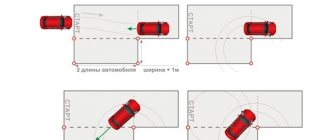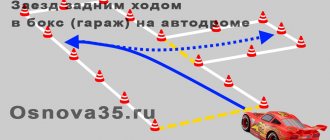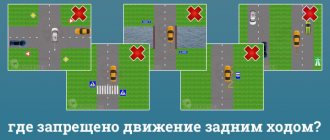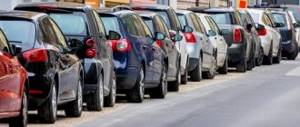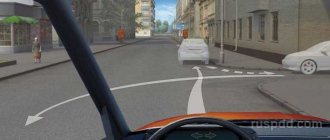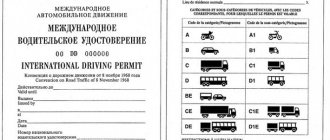Oddly enough, many even experienced drivers feel extremely insecure when it comes to such a common maneuver in a metropolis as parking. However, this can be explained by the fact that until recently drivers were not taught how to park. But even now, despite the inclusion of this element in driving tests, unfortunately, there is no need to talk about good parking skills.
The result of such general driver illiteracy is obvious - you will hardly be able to immediately find a car on the street that does not have damage to its paintwork. There is no doubt that most of them are the result of a collision with fences, poles, curbs or other vehicles after another attempt to park the car in conditions of limited free space.
Meanwhile, there is nothing particularly complicated in this maneuver - parallel parking in fact turns out to be no more difficult than entering/exiting a garage.
What is meant by parallel parking?
It’s very simple - this is when all cars are parked on one side of the road strictly parallel, because this allows other vehicles to drive on the roadway without problems. The problem is that the cars are placed quite tightly, and if there is space to place another one, it is usually small. Why is this happening? It's simple: drivers leave just enough space in front and behind so that they can back up a little and then enter the main lane without any problems.
And when one space becomes vacant, the entrance to the front and rear is blocked, and you can only get into this parking space by maneuvering correctly. Not all drivers know how to do this exactly correctly.
It can be argued that this skill is influenced solely by driving experience, but this is not entirely true: the driver will also need a sense of the dimensions of his car, which may not appear even after 10 years of driving. Well, in addition - the ability to determine with sufficient accuracy the distance to an object, looking exclusively in the mirrors. This skill requires special training.
If you have all these skills, the parallel parking scheme performed in reverse will not seem like the height of driving skill.
Please note that traffic regulations require special markings on city roads indicating the possibility of parallel parking. However, it so happens that even without these markings it is difficult to find a street on the right side of which there would not be a long line of parked cars. In principle, no one prohibits parking a car where there are no corresponding restrictive signs, including solid marking lines. So park safely - the main thing is that you do not interfere with the main traffic.
Why do you need to know?
The ability to park in reverse makes life easier for those behind the wheel and for everyone who is in the parking lot at that moment. It's not just a matter of making sure the driver doesn't accidentally hit someone when pulling into a parking lot. If he first parked in the forward direction (this seems more convenient to many), then he will have to drive out in reverse.
This is much more difficult and for a novice driver very often ends in damage to someone else’s car and a showdown with its owner.
Parallel parking size
In driving schools, this exercise is performed in a special area with strictly limited dimensions. The dimensions of the site are designed in such a way that the future driver masters the skills of parallel parking in relation to conditions that are as close as possible to real ones. This allows you not only to learn how to park carefully, without causing damage to your own and nearby cars, but also to do it safely for other participants in city traffic.
That is, the well-known rule “difficult to learn, easy to fight” applies. Indeed, in a real situation, spatial restrictions are not always so severe. The standard defines the length of a parking space as two meters - it is believed that this is enough for a safe drive between the cars behind and in front, with a width equal to the width of the parked car plus one meter of reserve. But in driving schools they treat this even more strictly: both during classes and during the exam, the driver must drive the car into a rectangular area measuring 8.80x2.80 meters. This is less than the standard and much smaller than the parallel parking sizes typically found in real world conditions.
But the fact is that in a driving school, an applicant for a driver’s license drives one car and owns another, and their dimensions may differ significantly. Of course, no one is going to prescribe rules for specific car models - the standard stipulates that the average car has a length of 4.4 meters and a width of 1.8 meters. One way or another, after passing the exam, the car owner will need to spend some more time to adapt the acquired skills to his vehicle.
Exercise diagram
The exercise area should be a section of road on which two imaginary cars are parked. At the same time, the distance between them is clearly established - it should be 2 times the length of the training machine. The training area must have markings. The size of the car, moreover, should not exceed the standard dimensions by more than 30 cm.
The “parallel parking” maneuver may well be useful not only in the exam, but also in real life. Parking a car can sometimes be quite problematic, since as the number of cars increases, there are often not enough parking spaces. As for this method of driving a car, it is not indicated in the traffic rules.
But such parking in a limited space can only be done in reverse, since to maneuver in front you will need a distance of not two, but three cars. Moreover, such a box can imitate not only a parking lot, but also a garage - accordingly, you need to drive into it without touching its walls.
Parallel parking rules
Before you start learning how to park in reverse, you should familiarize yourself with the basic rules for performing this maneuver:
- The minimum distance between those standing in a row and your car should be one and a half meters. This is a very serious requirement, compliance with which by all road users guarantees the absence of all kinds of excesses. And if you decide that one meter is enough for you to travel normally, this does not mean that your front neighbor has the same skill. And it’s not at all a fact that you’ll be the first to want to leave the parking lot. In this case, of course, the neighbor will either wait for you with curse words, or decide to leave, despite the possible damage to his and, note, your car. So if you do not respect yourself, show driver solidarity and tolerance towards other motorists by maintaining this minimum distance between two cars when parallel parking in reverse.
- Think also about those drivers who are moving in the main traffic. If your car is parked crookedly and sticks out a lot, it will make it difficult for the main traffic to pass, increasing the likelihood of various unexpected collisions and congestion caused by a single careless driver.
- Even if you are sure that you performed parallel parking correctly, do not be lazy when you get out of the car and see this with your own eyes by assessing the distance to neighboring cars. If you see that the car is parked incorrectly, take a couple of minutes to correct the situation. This will make you feel safer too.
By adhering to these rules (which can also be called recommendations), you will make your contribution to ensuring the safety of your DD.
A few useful secrets
For novice drivers with minimal experience, parallel parking in reverse is a difficult maneuver, but it can and should be learned, with several valuable tips to help:
- Many beginners are convinced that it is better to parallel park while moving forward. This is wrong. Firstly, when completing the maneuver you will still have to engage reverse gear. Secondly, when driving in reverse, the car reacts much more readily to the slightest turn of the steering wheel; when driving in front, such maneuverability is simply unattainable. This is elementary geometry, because only the front wheels turn. Another thing is that when reversing you need to be extremely careful and collected, because the cost of a mistake is very high.
- You need to start parking in an empty space by driving up to the front car as close as possible, about 50 centimeters. For beginners, determining the distance to the nearest object is a problem, and if in doubt, do not take risks: put the car on the parking brake, get out and evaluate whether you can drive even closer or whether you are already almost running into the front car.
- Many even experienced drivers begin the maneuver by turning the steering wheel in place. This can indeed make it easier to get into a free space, but this is far from obvious, because when you turn the steering wheel while standing, you do not control the angle of rotation of the wheel. But if it’s more convenient for you, remember that sooner or later such a habit will result in a serious breakdown, because the car’s chassis is not designed for such exercises.
Possible errors and difficulties
The examinee has little room for error. Strictly speaking, there are none at all. For gross mistakes, three penalty points are awarded at once. Namely, this is exactly what is needed to consider the exam failed. Therefore, the candidate clearly remembers how and why he is maneuvering, whether he is far enough away from other conventional machines and whether he is within the time frame.
| Error | Penalty points |
| Exceeding the time limit (two minutes) | 3 |
| Knocked down cones, crossing lines | 3 |
| Failure to cross the CB control line | 3 |
| Failure to cross the control line AB at the final stage | 3 |
| Stalled engine | 1 |
But this exercise is possible for absolutely everyone who wants to get behind the wheel - just learn the rules of the maneuver and not be lazy in training. It will be useful to hire a car for additional hours of lessons if you feel that the standard time at a driving school is not enough.
Expert opinion
Ivan Chaykin, author of the article:
Issues relating to motorists' rights are often more important than they appear at first glance. A driver may lose his license or suffer other severe penalties due to ignorance or misinterpretation of laws and regulations. Do not be lazy to dive deeply into the essence of the issue being studied, do not hesitate to ask advice from professionals.
We invite you to read: Insured event under compulsory motor liability insurance: procedure for action in case of an accident
Issues relating to motorists' rights are often more important than they appear at first glance. A driver may lose his license or suffer other severe penalties due to ignorance or misinterpretation of laws and regulations. Do not be lazy to dive deeply into the essence of the issue being studied, do not hesitate to ask advice from professionals.
When performing the “parallel parking” exercise, novice drivers make mistakes especially often. As a rule, this is due to the fact that they do not feel the dimensions of the car. In addition, beginners usually confuse the direction in which they need to turn the steering wheel. So, in order to fail the traffic police exam, you need to:
- Do not meet the established 2 minutes;
- Hit markings and other equipment, as well as cross solid lines
- Do not cross the marked line at the beginning or end of the exercise
- Deviate from the established trajectory of movement;
- Allow the engine to stop
Sooner or later, such maneuvers will have to be performed not only on the site, but also on the street. Sometimes the distance between cars in a parking lot is even smaller, so immediately after receiving your license it is better to practice for the first time. This will help you feel more confident behind the wheel.
Parallel parking technique
If you are learning the basics of driving at a driving school, you can rest assured that this exercise will be included in the program somewhere at the very end, when you already have passable driving skills. But do not expect that you will be able to master this technique properly in one, maximum two times. Therefore, it makes sense to practice this yourself.
Here are step-by-step instructions for parallel parking, as it is taught at the race track (assuming there is both a front and rear car, and sufficient space between them):
- before starting the maneuver, turn on the hazard warning lights;
- then try to approach the front car at a distance of about 50 centimeters so that your front right wheel is located near the left rear corner of the car;
- engage neutral gear, regardless of the type of transmission - this is a mandatory requirement;
- carefully observing what is happening behind you, turning your head, engage reverse gear and slowly start moving;
- quickly turn the steering wheel to the right all the way so that your car moves as steeply as possible towards the right rear corner of the parking area;
- as soon as you see the right headlight of the car standing behind you in the left mirror (your seat will be level with the bumper of the car in front), align the steering wheel to a straight position and continue to slowly back up;
- when your front bumper is level with the bumper of the car in front, turn the steering wheel to the left and drive until the car is parallel to the sidewalk;
- if your car has become a little crooked, or closer to one of the neighbors, correct it;
- after completing the maneuver, put the steering wheel straight; if you have an automatic transmission, turn on the parking mode and do not forget to put the car on the parking brake;
- When you get out of the car, make sure that everything is done correctly, and you will not inconvenience your neighbors in the parking lot.
As you can see, the technique of parallel parking in reverse is not complicated, but mastering it requires three components:
- first study the algorithm in theory and remember its automaticity;
- practice performing techniques on the race track;
- remember how the car behaves when moving in reverse and at the same time actively turning the steering wheel.
When performing a maneuver, the driving school will install marking equipment that cannot be knocked down when passing the exam, which is why it is so important to master the skills of driving using rear-view mirrors when parallel parking in reverse.
Parktronics
To make life easier for drivers, new car models are equipped with parking sensors (other names: parking radar/pilot, parking assistant, parking assistant, lidar) - sensitive ultrasonic or electromagnetic sensors with an audio, voice or visual warning system, and you can also purchase more modern models radar with rear view camera. Sensors are placed at the front and rear of the machine.
They read distance, recognize nearby objects and judge them as potentially harmful or harmless. If there is too little space left to another object, the radar starts an audio or light warning. The cost of a parking assistant varies from 1,000 to 15,000 rubles. At the same time, the main criterion for the quality of a device is measured by the number of sensors; inexpensive parking sensors will have two, and luxury devices will have eight.
But, unfortunately, the miracle of technology that really simplified life for drivers is imperfect. Under the following circumstances, radar is more likely to hinder than help:
To make life easier for drivers, new car models are equipped with parking sensors (other names: parking radar/pilot, parking assistant, parking assistant, lidar) - sensitive ultrasonic or electromagnetic sensors
The presence of slush and dirt on the road in the cold season and beyond.- The sensor does not distinguish between thin and sharp objects that can cause harm to the car.
- More modern models, on the contrary, can recognize the smallest details, such as thin tree branches, and emit signals indicating danger, which greatly distract the driver.
- The radar can be seriously damaged by: driving over rough terrain, operating radio transmitting devices within the range of the device, or towing.
- Increased noise greatly interferes with the device’s ability to recognize objects.
- Attempts to park on a road with an uneven surface, unpaved surface, or a strong slope.
Of course, a lot depends on the manufacturer and model of the device. The choice of radar must be approached with full responsibility, because the safety of your car may depend on it.
So, correct and easy parallel parking will require persistence, training and new skills. At the same time, it is better to spend time on numerous rehearsals of the same movements than to pay for car repairs or compensate for damage to an unfortunate neighbor in the parking lot. Parking sensors can make life easier for drivers, but sometimes they malfunction. Therefore, in the end, you always have to rely on your own strength and knowledge of the technique of complex maneuvers.
